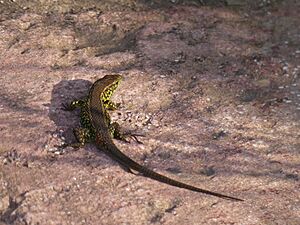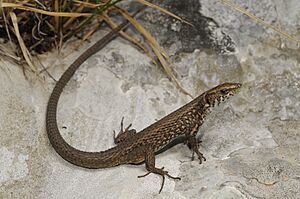Greek algyroides facts for kids
Quick facts for kids Greek algyroides |
|
|---|---|
 |
|
| Male, Kefalonia | |
 |
|
| Young male, Peloponnese | |
| Conservation status | |
| Scientific classification | |
| Genus: |
Algyroides
|
| Species: |
moreoticus
|
The Greek algyroides (also called Algyroides moreoticus) is a small lizard. It's sometimes known as the Greek keeled lizard. This lizard belongs to the Lacertidae family, which includes many types of lizards. You can only find the Greek algyroides in Greece. This means it is endemic to that country.
Contents
What Does the Greek Algyroides Look Like?
The Greek algyroides is a small lizard. It has special scales on its back that are large and have a ridge, like a "keel" on a boat. This is why it's called a "keeled lizard."
Male lizards are usually much more colorful than females. Females tend to be a plain brownish color. The patterns and colors on the males can be different depending on where they live.
For example, males from the island of Zakynthos have yellow sides. Those from Kefalonia and Ithaka have blue sides. Lizards living on the mainland Peloponnese have black and white patterns on their sides.
Where Do Greek Algyroides Live?
The Greek algyroides lives only in Greece. You can find them on the Peloponnese Peninsula. They also live on several Ionian Islands. These islands include Zakynthos, Kefalonia, Ithaka, and the Strofades islands.
These lizards like places with some shade. They live in open woods and along hedgerows. You might also find them at the edges of farms. They seem to prefer damp areas. They often hide among plants, fallen leaves, and brushwood on the ground.
Life and Habits of the Greek Algyroides
You might often see Greek algyroides lizards sunbathing. They like to warm up on wood or tree trunks. This usually happens in the late afternoon. During the hottest summer months, they can be harder to spot. They tend to hide more to stay cool.
Female Greek algyroides lay eggs. They usually lay only a few eggs at a time in each clutch.
Protecting the Greek Algyroides
The Greek algyroides is currently listed as "near threatened" by the IUCN. This means they are not in immediate danger, but their numbers could become low if things don't change. The biggest threat to these lizards is habitat loss. This happens when the places they live are destroyed or changed.


